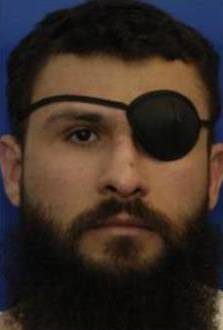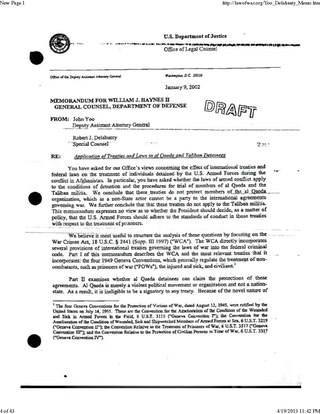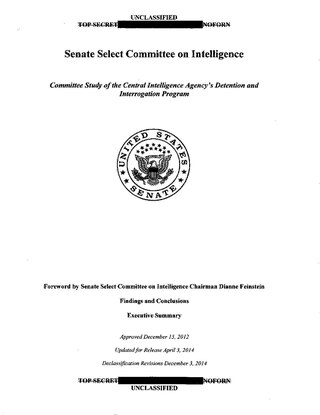Related Research Articles

Abu Zubaydah is a Palestinian citizen and alleged terrorist born in Saudi Arabia currently held by the U.S. in the Guantanamo Bay detention camp in Cuba. He is held under the authority of Authorization for Use of Military Force Against Terrorists (AUMF).

The American Psychological Association (APA) is the main professional organization of psychologists in the United States, and the largest psychological association in the world. It has over 157,000 members, including scientists, educators, clinicians, consultants, and students. It has 54 divisions—interest groups for different subspecialties of psychology or topical areas. The APA has an annual budget of around $125 million.

Waterboarding is a form of torture in which water is poured over a cloth covering the face and breathing passages of an immobilized captive, causing the person to experience the sensation of drowning. In the most common method of waterboarding, the captive's face is covered with cloth or some other thin material and immobilized on their back at an incline of 10 to 20 degrees. Torturers pour water onto the face over the breathing passages, causing an almost immediate gag reflex and creating a drowning sensation for the captive. Normally, water is poured intermittently to prevent death; however, if the water is poured uninterruptedly it will lead to death by asphyxia. Waterboarding can cause extreme pain, damage to lungs, brain damage from oxygen deprivation, other physical injuries including broken bones due to struggling against restraints, and lasting psychological damage. Adverse physical effects can last for months, and psychological effects for years. The term "water board torture" appeared in press reports as early as 1976.

Mohammed Mani Ahmad al-Qahtani is a Saudi citizen who was detained as an al-Qaeda operative for 20 years in the United States's Guantanamo Bay detention camps in Cuba. Qahtani allegedly tried to enter the United States to take part in the September 11 attacks as the 20th hijacker and was due to be onboard United Airlines Flight 93 along with the four other hijackers. He was refused entry due to suspicions that he was trying to illegally immigrate. He was later captured in Afghanistan in the Battle of Tora Bora in December 2001.
Medical torture describes the involvement of, or sometimes instigation by, medical personnel in acts of torture, either to judge what victims can endure, to apply treatments which will enhance torture, or as torturers in their own right. Medical torture overlaps with medical interrogation if it involves the use of professional medical expertise to facilitate interrogation or corporal punishment, in the conduct of torturous human experimentation or in providing professional medical sanction and approval for the torture of prisoners. Medical torture also covers torturous scientific experimentation upon unwilling human subjects.
The five techniques, also known as deep interrogation, are a group of interrogation methods developed by the United Kingdom during the 20th century and are currently regarded as a form of torture. Originally developed by British forces in a variety of 20th-century conflicts, they are most notable for being applied to detainees in Northern Ireland during the Troubles. The five collective methods are prolonged wall-standing, hooding, subjection to noise, deprivation of sleep, and deprivation of food and drink.

The Office of Legal Counsel (OLC) is an office in the United States Department of Justice that assists the Attorney General's position as legal adviser to the President and all executive branch agencies. It drafts legal opinions of the Attorney General and provides its own written opinions and other advice in response to requests from the Counsel to the President, the various agencies of the Executive Branch, and other components of the Department of Justice. The Office reviews and comments on the constitutionality of pending legislation. The office reviews any executive orders and substantive proclamations for legality if the President proposes them. All proposed orders of the Attorney General and regulations that require the Attorney General's approval are reviewed. It also performs a variety of special assignments referred by the Attorney General or the Deputy Attorney General.
Extrajudicial prisoners of the United States, in the context of the early twenty-first century War on Terrorism, refers to foreign nationals the United States detains outside of the legal process required within United States legal jurisdiction. In this context, the U.S. government is maintaining torture centers, called black sites, operated by both known and secret intelligence agencies. Such black sites were later confirmed by reports from journalists, investigations, and from men who had been imprisoned and tortured there, and later released after being tortured until the CIA was comfortable they had done nothing wrong, and had nothing to hide.

Jay Scott Bybee is an American lawyer and jurist serving as a senior U.S. circuit judge of the Court of Appeals for the Ninth Circuit. He has published numerous articles in law journals and has taught as a senior fellow in constitutional law at William S. Boyd School of Law. His primary research interests are in constitutional and administrative law.

Mohammed Farik Bin Amin, alias Zubair Zaid, is a Malaysian who is alleged to be a senior member of Jemaah Islamiyah and al Qaeda. He is currently in American custody in the Guantanamo Bay detention camp. He is one of the 14 detainees who had previously been held for years at CIA black sites. In the ODNI biographies of those 14, Amin is described as a direct subordinate of Hambali. Farik Amin is also a cousin of well-known Malaysian terrorist Zulkifli Abdhir.
Camp Nama was a military base in Baghdad, Iraq, originally built by the government of Saddam Hussein, from which its name derives, and now used by Iraqi military forces. Purportedly, the original Iraqi name has been repurposed by U.S. personnel involved with the facility as a backronym standing for "Nasty Ass Military Area".
"Enhanced interrogation techniques" or "enhanced interrogation" was a program of systematic torture of detainees by the Central Intelligence Agency (CIA), the Defense Intelligence Agency (DIA) and various components of the U.S. Armed Forces at remote sites around the world—including Bagram, Guantanamo Bay, Abu Ghraib, and Bucharest—authorized by officials of the George W. Bush administration. Methods used included beating, binding in contorted stress positions, hooding, subjection to deafening noise, sleep disruption, sleep deprivation to the point of hallucination, deprivation of food, drink, and medical care for wounds, as well as waterboarding, walling, sexual humiliation, rape, sexual assault, subjection to extreme heat or extreme cold, and confinement in small coffin-like boxes. A Guantanamo inmate's drawings of some of these tortures, to which he himself was subjected, were published in The New York Times. Some of these techniques fall under the category known as "white room torture". Several detainees endured medically unnecessary "rectal rehydration", "rectal fluid resuscitation", and "rectal feeding". In addition to brutalizing detainees, there were threats to their families such as threats to harm children, and threats to sexually abuse or to cut the throat of detainees' mothers.

The Behavioral Science Consultation Teams are groups of psychiatrists, other medical doctors and psychologists who study detainees in American extrajudicial detention.
James Elmer Mitchell is an American psychologist and former member of the United States Air Force. From 2002, after his retirement from the military, to 2009, his company Mitchell Jessen and Associates received $81 million on contract from the CIA to carry out the torture of detainees, referred to as "enhanced interrogation techniques" that resulted in little credible information.

Abu Zubaydah is a Saudi citizen who helped manage the Khalden training camp in Afghanistan. Captured in Pakistan on March 28, 2002, he has since been held by the United States as an enemy combatant. Beginning in August 2002, Abu Zubaydah was the first prisoner to undergo "enhanced interrogation techniques." Since the Spanish Inquisition, these practices have been characterized as torture by many familiar with the techniques. There is disagreement among government sources as to how effective these techniques were; some officials contend that Abu Zubaydah gave his most valuable information before they were used; CIA lawyer John Rizzo said he gave more material afterward.

Gul Rahman was an Afghan man, suspected by the United States of being a militant, who was a victim of torture. He died in a secret CIA prison, or black site, located in northern Kabul, Afghanistan known as the Salt Pit. He had been captured October 29, 2002.

A set of legal memoranda known as the "Torture Memos" were drafted by John Yoo as Deputy Assistant Attorney General of the United States and signed in August 2002 by Assistant Attorney General Jay S. Bybee, head of the Office of Legal Counsel of the United States Department of Justice. They advised the Central Intelligence Agency, the United States Department of Defense, and the President on the use of enhanced interrogation techniques—mental and physical torment and coercion such as prolonged sleep deprivation, binding in stress positions, and waterboarding—and stated that such acts, widely regarded as torture, might be legally permissible under an expansive interpretation of presidential authority during the "War on Terror".

John Bruce Jessen is an American psychologist who, with James Elmer Mitchell, created the so-called "enhanced interrogation techniques" that were used in the interrogation and torture of CIA detainees and outlined in the United States Senate Select Committee on Intelligence's report on CIA torture. In that report, he was mentioned under the pseudonym "Hammond Dunbar." His company, Mitchell Jessen and Associates, earned US$81 million for its work.
Michael E. Dunlavey is a former major general in the United States Army. Following his retirement from the Army he was elected a State Judge in Erie Pennsylvania.

The Committee Study of the Central Intelligence Agency's Detention and Interrogation Program is a report compiled by the bipartisan United States Senate Select Committee on Intelligence (SSCI) about the Central Intelligence Agency (CIA)'s Detention and Interrogation Program and its use of torture during interrogation in U.S. government communiqués on detainees in CIA custody. The report covers CIA activities before, during, and after the "War on Terror". The initial report was approved on December 13, 2012, by a vote of 9–6, with seven Democrats, one Independent, and one Republican voting in favor of the report and six Republicans voting in opposition.
References
- ↑ Bredemeier, Brenda Jo; David L. Shields (1984). "The Utility of Moral Stage Analysis in the Investigation of Athletic Aggression" (PDF). Sociology of Sport Journal. 1 (2): 138–149. doi:10.1123/ssj.1.2.138 . Retrieved 27 August 2012.
- ↑ "RULE NO. 12-FOULS AND PENALTIES". NBA.com. 2001-01-31. Archived from the original on 2009-03-23. Retrieved 2012-07-13.
- 1 2 Schmitt, Eric (March 19, 2006). "In Secret Unit's 'Black Room,' a Grim Portrait of U.S. Abuse". The New York Times. Retrieved 27 August 2012.
- ↑ Luban, David; Shue, Henry (2011). "Mental Torture: A Critique of Erasures in U.S. Law". Georgetown Law Scholarly Commons. Georgetown Law Library. Retrieved 20 July 2020.
- ↑ (subscription required)
- ↑ A Republic of Statutes: The New American Constitution - William N. Eskridge, John Ferejohn - Google Books.
- ↑ Gross, Michael L. (2004). "Regulating Torture in a Democracy: Death and Indignity in Israel". Polity. 36 (3): 367–388. doi:10.1086/POLv36n3ms3235383. JSTOR 3235383. S2CID 157448056.
- ↑ Vesti, Peter; Lavik, Niels Johan (1991). "Torture and the Medical Profession: A Review". Journal of Medical Ethics. 17 (Suppl): 4–8. doi:10.1136/jme.17.Suppl.4. JSTOR 27717098. PMC 1378160 . PMID 1795371.
- 1 2 "War Crimes by Doctors and Psychologists | Nat Hentoff | Cato Institute: Commentary". Cato.org. October 2009. Retrieved 2012-07-13.
- ↑ New Deal 2.0 / By Lynn Parramore (2011-03-17). "How Bradley Manning's Treatment Is Tarnishing the Military Psychiatry Profession | Civil Liberties". AlterNet. Retrieved 2012-07-13.
{{cite web}}: CS1 maint: numeric names: authors list (link) - ↑ Sullivan, Andrew (2006-06-23). "How Doctors Got Into the Torture Business". TIME. Archived from the original on July 3, 2006. Retrieved 2012-07-13.
- ↑ Halpern, Abraham L "Enhanced" interrogation of detainees: do psychologists and psychiatrists participate?
- ↑ "Access". Medscape. Retrieved 2012-07-13.
- ↑ Dentzer, Susan (Feb 7, 2005). "Dr. Bagian on Medical Errors". PBS. Retrieved 27 August 2012.